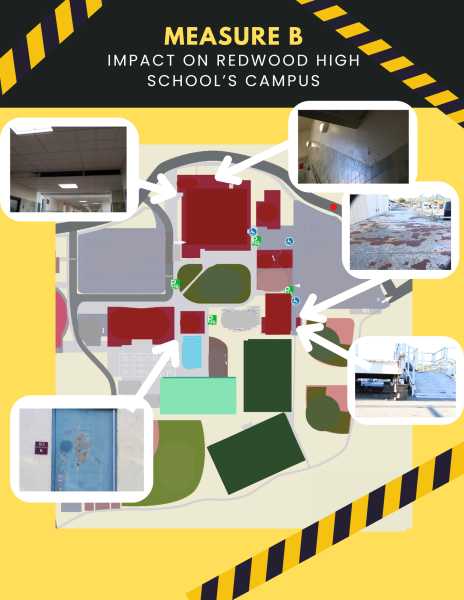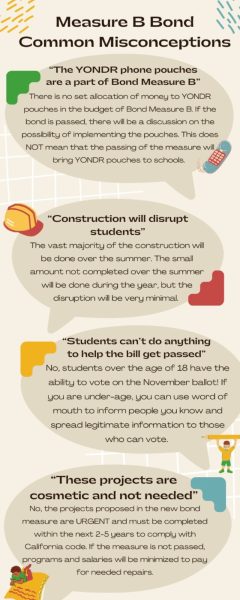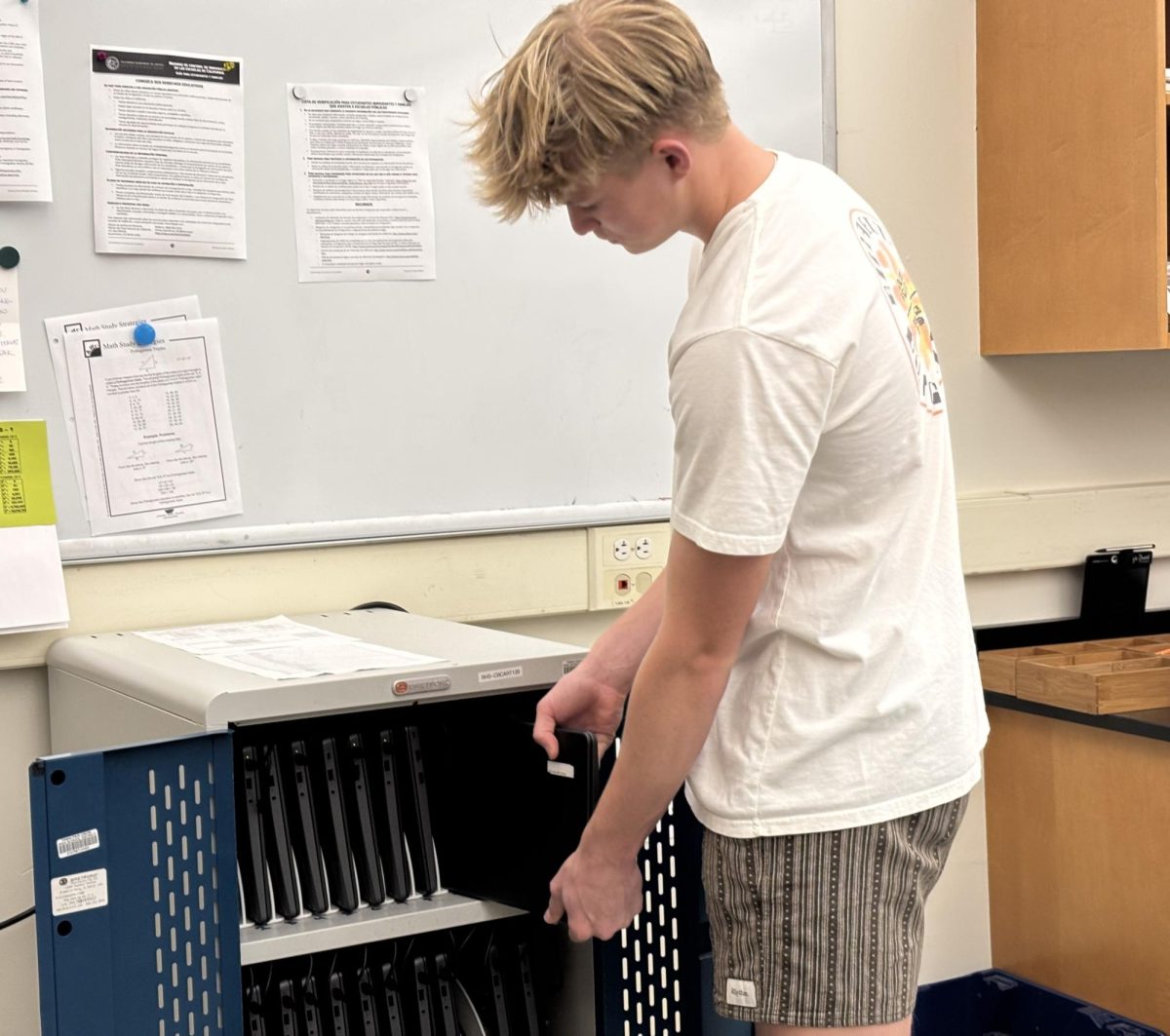Amidst many conversations about Bond Measures passing in Marin school districts, the one word consistently repeated is “urgency.” After missing the necessary 55 percent approval for Bond Measure A last March by just one percent, the Tamalpais Union High School District (TUHSD) is urging voters to think again in hopes of passing the new and improved Bond Measure B, which will appear on the Nov. 5th ballot. The latest proposal has cut the initial 517 million dollars almost in half; Measure B comes in at 289 million dollars and will help critical facility improvements that cannot be funded by the state.
Redwood is ranked 36th in California High Schools by U.S. News Ranking; this prestige should not be overshadowed by a lack of funding and support from the community.
The state legally mandates construction in the next two to five years to maintain a safe and modern school. Senior Charlie Scott, youth advocate for the Measure B Bond, has been particularly vocal, as he feels it is necessary for not only the district in general but specifically Redwood. If Measure B does not get passed, resources will have to be cut from other programs to fund the necessary improvements.

“We certainly need upgrades. This is our chance to do it because if we don’t [pass Measure B] now, [the upgrades] are going to cut into our budget for teachers. We have to replace [them to meet state standards]. The roofs are failing and we legally have to replace them. So then all of a sudden, you have to start laying off teachers and the school falls apart,” Scott said.
If passed, the 289 million dollar bond would fund essential projects like roof repairs and upgrades to Heating, Ventilation and Air Conditioning systems (HVAC). Other projects like new classrooms for the arts, a larger cafeteria, new turf on Ghilotti field and replastering the pool would all happen with a 103.3 million dollar allocation going specifically to Redwood High School. The construction would not heavily impact student life, with the bulk of it being done in the summertime. If it is not passed, teachers may be laid off, programs, like Bark, could be shut down and variety in class offerings will be diminished to fund construction needs.
Although Scott is a current senior and won’t see the effects of Measure B passing, he feels the need to use his student voice for the future generation, specifically his younger sister. Scott’s concern was prompted because of the similarities he saw in a much smaller bond measure his freshman year.
“I remember when I was coming into Redwood as a freshman, there was a similar bond measure called Measure M [and] I was really worried about what would happen to class sizes and all that stuff if it didn’t pass,” Scott said.
While Measure M was able to pass, the same concern is being transferred to Measure B.
“It’s important to look at [the bond] for your community and that’s exactly what this is,” Scott said.
Also on the state ballot is Proposition 2, which proposes $8.5 billion for K-12 school renovations, allocated through matched grants by the state. If both Prop 2 and Measure B pass, TUHSD will receive additional funding from Proposition 2 on top of the 289 million dollars from Measure B.
Across the spectrum, students, teachers and parents alike have recognized the immense impact Measure B could have on student life and education. TUHSD’s Assistant Superintendent of Business and Operations, Corbett Elsen, has had a large role in the project, as has worked on both Bond Measure A and Bond Measure B.
“A bond measure in California is the only real viable way for schools to upgrade their facilities and we’re all here resting on the shoulders of our community passing the bond measure 20 years ago and 40 years ago. Bond measures [are] a once-in-a-generation endeavor, and now [it is] our turn,” Elsen said.
The last facilities-focused bond measure was passed in 2001; the money from which is still funding TUHSD’s programs, like seven period days that offer more curriculum opportunities to students.
To the naked eye, Redwood’s campus may look fully functioning, but projects have been pushed for far too long. Improvements are no longer cosmetic but instead are urgent safety concerns.
“The safety of our students and staff is the only thing more important than the teaching [and] learning process. So it’s important that we’re ahead to identify what things don’t have dedicated funding with [the] bond, and would trigger major budget cuts to students and staff,” Elsen said.
As a mother and Measure B committee member, Lauren Vaughn emphasizes how important it is for our community to have such highly established public schools.
“We live in a community that has a lot of wealth [that] sometimes forgets the importance of putting what they can towards public education,” Vaughn said.

Scott also mentioned the effect that the school’s infrastructure has had on his learning experience, especially during lunches.
“One of the biggest things is the cafeteria. You go into the cafeteria, it’s in the winter time, and no one really likes to sit in there. [When] you look for a place to sit for juniors and seniors, it’s easy; just go sit in your car. For freshmen [and] sophomores, they’re sitting in the hallways on the floor and [that is] no good space to eat,” Scott said.
With inconsistent weather patterns most of the school year, it seems both functional and expected to have a working cafeteria for students to find refuge, which would be created with the bond measure.
One advantage of the publicity from Bond Measure B has been the surge of involvement from teachers and community members, which parent and Measure B committee member, Cari Dauphinain, has noticed.
“I think people are feeling passionate about [the Bond], particularly the teachers. I think they feel that the amount of courses in the seven period day is so critical to a really strong high school education. When people see that [it’s] potentially at risk, people have [really] felt the need to get involved,” Dauphinain said.
In addition to parent involvement, students who are 18 or older can get involved by voting on Measure B. Those who are not old enough to vote can do their part by spreading word of mouth to those who can, and staying educated with the true facts from credible sources. With a bond measure that covers numerous projects, it’s easy for things to be lost in communication or for questions to arise. For transparency, anyone can access the Measure B website, various social media pages and directly ask anything on their mind during the Virtual Measure B Information Sessions. Additionally, above is a list of frequently asked questions and common misconceptions. Voting for Bond Measure B will take place on Nov. 5th, 2024.










